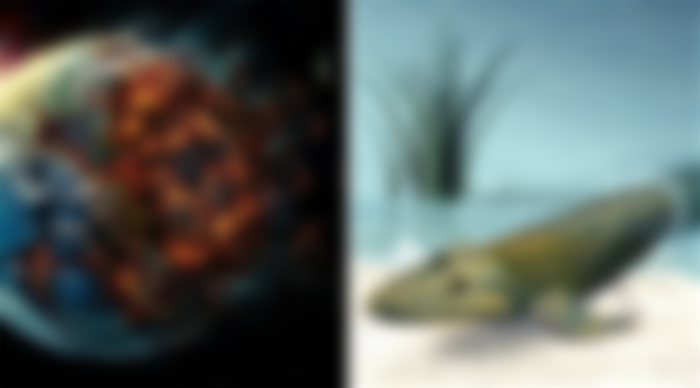25 important milestones of our planet, which has existed for 4.5 billion years, prepared in chronological order from the evolutionary process to life, from the formation of the earth to the shaping of space.

birth of the world
4.5 billion years ago
The earth was formed from a cloud of dust and stones revolving around the young sun. The gravitational force created the world by pulling the rocks and every other matter around it. The moon was later formed by the condensation of a cloud of debris formed when a planet-sized chunk of rock collided with the earth.
origin of life
4-5 billion years ago
It is not known exactly when life began. The oldest single-celled fossil is 3.5 billion years old. life may have started a little earlier, but it is unlikely to occur during periods when large rocks continued to rain down on the earth. Life may have started at the bottom of the sea, in the open sea, or on land, but we don't yet know where it started and what the first organisms looked like.
using the energy of sunlight i.e. photosynthesis
3.4 billion years ago
all life forms need energy to survive, the biggest source of energy for life on earth is the sun. Some early microorganisms evolved to use the energy of sunlight to turn simple molecules into sugars (carbohydrates). This process is called photosynthesis. but unlike today's green plants, the first photosynthesizing organisms did not produce oxygen as waste, meaning there was no oxygen in the air.
Beginning of plate tectonics, that is, continents are formed
3 billion years ago
Today, the Earth's surface is divided into several dozen slabs of rock. sometimes it drifts onto one another, causing it to perish in the planet's evolved core. This process is called plate tectonics, thought to have begun about 3 billion years ago. With plate tectonics working, the first continent called "ur" was formed.
breathable air
2.4 billion years ago
For half the age of the Earth, there was almost no oxygen in the air. Later, some bacteria began to use sunlight to convert carbon dioxide and water into sugar (carbohydrates), similar to today's green plants. These organisms began to release oxygen intensively into the atmosphere as a waste product, creating today's oxygen-rich atmosphere. but the first oxygens may have caused the earth to freeze into a snowball planet by reducing the greenhouse gas methane in the air.
endosymbiosis – complex cells
2-1 billion years ago
The first organisms were simple cells similar to modern-day bacteria, but some later evolved into more complex ones. These "eukaryotes" developed a lot of specialized equipment inside their cells. Also, sausage-shaped object called mitochondria began to be used as a new energy source. Mitochondria, a bacterium that once lived separately, were absorbed in a process called endosymbiosis. All the animals and plants you see around you are eukaryotes.
the origin of the first sex i.e. mating
1.2 billion years ago
The period between 1.8 billion and 800 million years ago was a time when fossil remains were boring—in fact, this period is called the "boring billion." but behind the scenes something new was happening. one of them is the possibility that sex evolved during this period. While it is unclear why and when, some organisms simply stopped dividing in two and began to reproduce through sex. What was certain to happen 1.2 billion years ago was that fossils of red algae contained sex-specific cells, such as spores.
multicellular life – large organisms
1 billion years ago
For the first time, life wasn't all single-celled. Today, cells form a unity, forming large organisms with structures such as the mouth, limbs, and sense organs. Although it is not certain when this first began, and large fossils of organisms can be seen as far back as 2.1 billion years, there is also the possibility that they were colonies of simple bacteria. different groups of organisms probably evolved independently of one another to multicellularity. plants, for example, formed this type of life before animals.
Snowball World
850-635 million years ago
In 200 million years, the earth has been completely frozen twice. The ice sheet almost covered a large area from the poles to the equator. The second snowball phase may have triggered the evolution of the first complex animals. The first complex, strange tubular or fern-leaf-shaped organisms called ediacarons began appearing soon after the second snowball stage.
Cambrian explosion – evolutionary leaps
535 million years ago
After animals evolved, there were two evolutionary leaps. In the Cambrian explosion, almost all modern animal groups began to appear within tens of millions of years. This period may also give the appearance of an "explosion" due to better fossilization of animals with hard shells. Then, during the great Ordovician biodiversity event 489 million years ago, each animal group expanded further.
colonization of plants on land, that is, exit from the sea
465 million years ago
some animals came ashore 500 million years ago, but only on short visits – perhaps to hide their eggs out of reach of predators. plants became the first permanent settlers of the land. The first land plants were evolutionary relatives of green algae, but they quickly diversified.
first mass extinction
460-430 million years ago
In the Ordovician period, life became ostentatious. but it's also nearing the end. The earth cooled and floes of ice began to spread from the poles. This ice age was called the Andean-Saharan because of the evidence found in the Andes and the Sahara desert. The extreme cold brought about the second largest mass extinction in Earth's history: most Ordovician-Silurian life forms lived in the seas, and 85% of marine life went extinct. fish became more common as a result.
fish that walks on land, from fin to leg
375 million years ago
The next step after the successful settlement of plants on land was the emergence of animals from the water. Insects came ashore 400 million years ago. In a short time, the tiktaalik, a large vertebrate, salamander-like fish, followed the insects. Eventually, four limbs evolved in fish, leading to amphibians, reptiles, and mammals. perhaps it would have been a better step for them to emerge from the water at this time, because some time later, in the late Devonian extinction, many sea creatures went extinct.
Dawn of the Reptiles
320 million years ago
When the first reptiles appeared, the world was in an era called the late Paleozoic ice age. Reptiles evolved from salamander-like amphibians. Unlike their ancestors, they have hard and scaly skin, while their eggs have hard shells and do not have to lay their eggs in water. Thanks to these advantages, they soon became the dominant land animals. Dimetrodon, which had a sail-like formation on its back, reached a length of about 4.5 meters. Contrary to popular belief, dimerdon is not a dinosaur.
supercontinent – Pangea
300 million years ago
For the last time, all the continents on Earth came together to form a single "supercontinent". Known as pangea, this continent was surrounded by an ocean called penthalassa, which covered the entire globe. This formation, which lasted until 175 million years ago, began to separate in the next tens of millions of years, and the modern continents we know began to form.
great extinction – Permian extinction
252 million years ago
In this period when reptiles diversified, life on earth went through perhaps the most difficult period. The Permian extinction caused the worst mass extinction in the history of the planet. About 96 percent of marine and land species went extinct. Although it is not known exactly what caused this event, large volcanic eruptions – which formed the present-day Siberian volcanic rock landscape – may have caused the extinction. After these events, the first dinosaurs appeared.
first mammals - hairy creatures
220 million years ago
During this period when dinosaurs emerged and diversified, the first mammals evolved. The ancestors of mammals were reptiles called cynodonts. There is also the possibility that these creatures, whose faces are somewhat dog-like, may have fur or bristles. Early mammals such as morganucodon were small, mouse-like, and probably nocturnal active. this may have allowed them to evolve a warm-blooded body structure that allowed them to maintain a constant temperature.
Triassic extinction – spread of dinosaurs
201 million years ago
dinosaurs became very flamboyant on land, while in the sea giant reptiles called ichthyosaurs became the foremost predators. Then a new disaster struck. No one knows the cause of the Triassic extinction, but it caused the extinction of about 80% of living species. Afterwards, the dinosaurs, which became dominant on land, reached gigantic sizes. Dreadnoughtus schrani, the largest known species, could reach a weight of about 59 tons.
first birds – feathered flight
160 million years ago
birds evolved from feathered dinosaurs – modern birds are actually velociraptors with beaks instead of noses and wings instead of arms. The most familiar early bird, Archeopteryx, lived 150 million years ago. but in recent years, earlier fossils of xiaotingia and auromis have been found in China.
flowers bloom - the plant revolution
130 million years ago
It may seem a little strange, but flowers appeared relatively recently. plants have lived on land for about 465 million years, but flowers did not appear for more than two-thirds of that time. Flowering plants emerged in the middle of the dinosaur age. Grasses of the same name appeared much later. The oldest grass fossils are 70 million years old, and may have evolved a little earlier than this time.
extinction of dinosaurs - fifth extinction
65 million years ago
65 million years ago, a huge asteroid struck the region of present-day Mexico. The explosion was very violent, and the long-term effects that followed were even worse. The dust splashed up into the upper atmosphere, blocking out sunlight, and the ensuing cold and darkness caused the fifth and final extinction. Dinosaurs were among the most well-known disappearances, but pterosaurs and large marine reptiles went extinct as well.
evolution of the first primates – living in trees
60-55 million years ago
Just after the dinosaurs died out, mammals became capable of nurturing and raising their young in their wombs with the help of the placenta, just like today's modern humans. After a while, the first primates evolved from early placental mammals. These primates later evolved into monkeys, apes, and humans. Archicebus achilles, the oldest known primate, weighed no more than 30 grams. They lived in hot and humid rainforests in Asia.
high energy plants – c4 photosynthesis
32-25 million years ago
Plants have been busy with the process of photosynthesis, the process of producing sugar using sunlight for hundreds of millions of years. Relatively recently, some plants have found a way to do this better. C4 photosynthesis can perform this process much more effectively, even under difficult conditions, than normal photosynthesis. Today, scientists are looking for a way to enable rice to use c4 photosynthesis to meet the food needs of the growing population.
first hominids – the way to humanity
13-7 million years ago
The first apes (apes) appeared in Africa 25 million years ago. At some point this group split off, giving rise to humans, chimpanzees, gorillas, and orangutans. It is not certain when these distinctions occurred, but the earliest known hominid, sahelanthropus tchadensis, lived 7 million years ago.
human species
200 thousand years ago
Our species, Homo sapiens, is still very young. they only existed for the last one-fifth of the last million years. In this time, they have reached all the continents and even outer space from Africa, the birthplace of our species. our actions may have caused the sixth extinction and the fastest climate change. Despite this, human beings are perhaps the first species to bring together and understand what happened in the history of the world.
